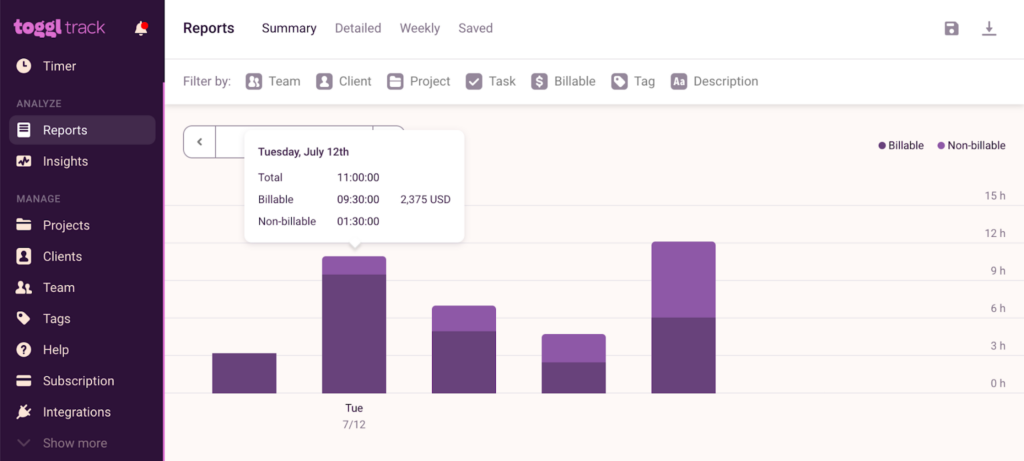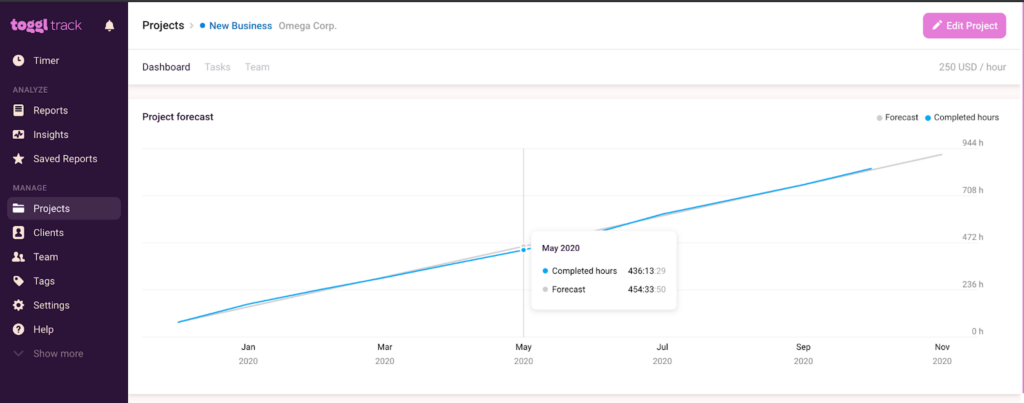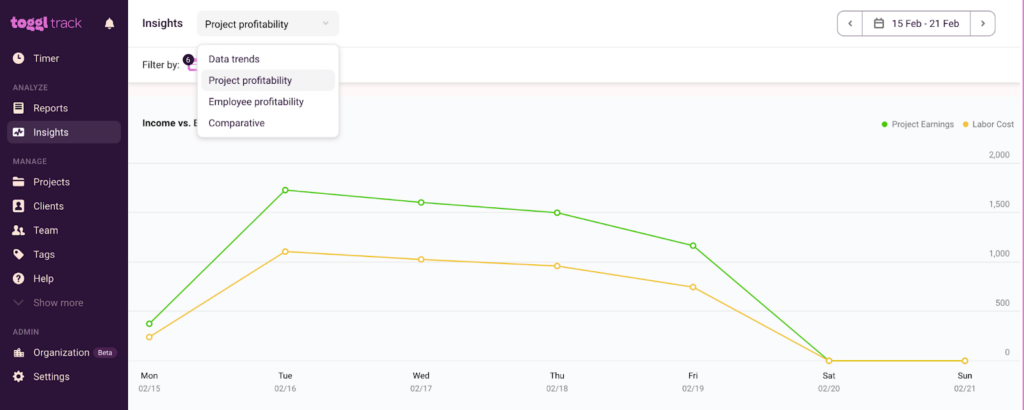A timesheet reports the total hours an employee has worked over a specific period.
Employees typically submit timesheets weekly, bi-weekly, or monthly. Businesses use this data to process payroll, bill clients, and track employee utilization and productivity.
But are they accurate and worth the hassle?
In this article, you’ll learn what timesheets are, their benefits, their common uses, and how timesheet software helps you create accurate timesheets without the hassle.
Let’s dive in.
What is a timesheet?
A timesheet is a summarized report of an employee’s work hours over a certain period of time.
It’s tabulated based on the time entries logged by employees.
A time entry is a granular record of an employee’s start and stop times when working on a task or project.
While time entries are an accurate and complete record of the hours worked, they aren’t useful for payroll processing, client billing, or management accounting.
For example, to process payroll based on time entries, the accounting team would have to:
- Go through each time entry
- Classify it as regular hours or overtime
- Aggregate the entries into hours worked
- And then pay accordingly
It’s simply too much work.
That’s where a timesheet helps. It presents a tabulated summary of an employee’s work hours.
Today, timesheet software gives you a real-time, summarized overview of your employees’ work hours.
But timesheets go a long way back in time.
Brief history of timesheets
If you’re wondering how timesheets evolved, their origins date back to 1772 BC.
Ancient civilizations in Babylon used the Code of Hammurabi, which regulated worker hours and wages.
This was one of the first recorded attempts to manage labor and pay workers based on output.
Timesheets became more structured during the Industrial Revolution when mechanical time clocks and punch cards were invented.
With desktop computers becoming commonplace, spreadsheets were used to record and compile timesheets.
Today, timesheet software gives you the power to report employee work hours in real time and gain insights to improve productivity and profitability.
Why do employers use timesheets to track employee work hours?
Timesheets help employers track work hours, process payroll, and report billable hours to clients.
It’s also used to track time off, lunch breaks, and attendance making it useful for tracking employee productivity and utilization.

The timesheet format is simple and flexible to implement, whether you use manual methods or software.
How does a timesheet work?
With the manual system, employees fill their daily, weekly, or monthly timesheets as part of the company’s time-tracking policy.
After completing their timesheets, employees submit them to their manager for approval.
Timesheet software makes this process more granular and accurate. Employees record the exact time they start and stop working on a task or take a break as time entries.
Digital timesheet apps compile time entries, summarize them into work hours, and present them in a format that’s useful for payroll, invoicing, or accounting.
In addition, they also offer features like:
- Start/stop timers to record time entries
- Time tracking reminders
- Timesheet approvals
Once a manager approves the timesheet, it’s sent to the accounting team for processing payroll or billing clients. These timesheets are also used by the HR team to analyze employee productivity, utilization, and workload.
Toggl Track offers both options:
- If you have up to five employees, you can sign up and use its timesheet software for free
- Alternately, you can use the free free Time Clock Calculator, to generate timesheets based on tracked time and breaks.
What information does a timesheet include?
To make your timesheets as accurate as possible, make sure to include the following:
- Employee details: Each timesheet typically begins with the employee’s name and job title.
- Dates and hours worked: You should also add workweek dates and the specific number of hours worked each workday. Plus, you can also tag work hours as billable or non-billable and regular hours or overtime.
- Tasks and projects: Employees must specify the tasks or projects they worked on during logged hours.
- Breaks and time off: Timesheets include lunch breaks and time off.
- Approval section: Finally, timesheets should include an approval section that managers use to approve or reject the timesheet.
Here’s what a weekly timesheet looks like:

What are the types of timesheets?
Depending on your business needs and employee schedules, these are the main timesheets you might use:
| Type | Description | Uses |
|---|---|---|
| Daily timesheet | Captures how employees spend time on a day-to-day basis | Tracking employee productivity and utilization |
| Weekly timesheet | Gives an overview of an employee’s work hours for an entire week | Client billing |
| Bi-weekly timesheet | Similar to the weekly timesheet, but it covers two weeks of work | Client billing and payroll |
| Monthly timesheet | Provides a summary of an employee’s work hours for an entire month and can be useful for employees with consistent work hours | Client billing, payroll, and labor law compliance |
| Project-focused timesheet | Tracks time spent on specific tasks within a project | Project time management and client billing |
To speed things up, you can use our free timesheet templates. Choose from daily, weekly, monthly, project, and other templates.
Paper timesheets vs. digital time-tracking apps
Using paper timesheets is better than not tracking time at all, but digital time-tracking apps are the better alternative.
As we’ve seen, paper-based timesheets rely too much on memory and are time-consuming. Employees don’t like to add their time on timesheets because it feels like an extra task.
The much more intuitive and less time-consuming alternative is to use time-tracking apps, which simplify the process of tracking time.
Employee time-tracking software like Toggl Track is easy to use, accurate, and has powerful features that maximize the benefits of tracking time.
With a digital time-tracking app like Toggl Track:
- Freelancers and teams track time accurately in just a few clicks
- Managers get faster and more detailed data to analyze productivity
- Time data can be visualized using customizable reports
- There’s less admin work and more time to focus on productive work
What are the benefits of using timesheets?
Freelancers and companies who use timesheets can reap benefits like:
- Accurate payroll processing
- Fair client billing and transparency
- Improved employee accountability and time management
Let’s examine the main benefits of timesheets and how a dedicated timesheet app can help you maximize these advantages.
Accurate time tracking
When employees log their time on timesheets, managers get a clear overview of how their team spends time. They can also use this data to create accurate client invoices and pay their employees fairly.
But let’s be honest: manual timesheets are neither timely nor accurate..
- Employees often forget and must constantly be reminded by managers to submit timesheets.
- They often put off updating timesheets until the last minute, so the timesheets are often an approximation of the actual work hours.
- Managers have to spend hours compiling and reviewing timesheets manually which can result in oversight and error.
The good news is there is a better way.
With a timesheet app like Toggl Track, employees can track their time on multiple devices (mobile, desktop, browser extension) in just a few clicks.
Here’s how:
- Write the name of the task you’re working on.
- Select the project to which this task belongs from a predefined list.
- Start the timer.

Toggl Track also sends reminders to notify you if you’ve forgotten to stop the timer or to notify you when you haven’t tracked enough time.
These features improve the time-tracking accuracy, making it easier and reducing data entry errors.
Workflow optimization
Timesheets give managers valuable data they can use to analyze and optimize team workflows.
With complete visibility into their employees’ work hours, employers can spot:
- Productivity gaps
- Inefficient work habits
- Bottleneck tasks
However, manually analyzing this data is a pain and can take time.
Wondering if there’s a better way?
Toggl Track’s Reporting feature allows for easier, faster, and more in-depth time analysis and reporting.
The app automatically generates Summary, Weekly, or Detailed reports that show:
- Billable and non-billable hours tracked
- Earnings-per-client and ROI
- Detailed time entries for the whole team

Streamlined project management
When employees clock in time spent on projects using timesheets, tracking project progress and anticipating delays is much easier.
Tracked project hours also tell project managers how many tasks are needed so they can make more accurate estimates for future projects and organize tasks realistically.
Again, manually doing this takes time and effort, which can be significantly reduced with automated timesheet software.
For example, the Project Dashboard in Toggl Track analyzes project performance and displays its progress in easy-to-read charts.

The Project Dashboard shows:
- Predicted project completion dates
- Forecasts of hours tracked in the future
- Predicted billable amounts tracked in the future
Toggl Track’s Insights feature offers detailed information about project profitability and trends that you can use to manage your projects better.

Here, you see project earnings and losses, compare projects, and analyze labor costs and billable hours.
With these insights into project progress and profitability, you are better equipped to handle projects effectively.
Improved customer relations
Clients trust the service provider more when they know what they are paying for.
To bill clients accurately and transparently, you must record every billable minute spent on client work.
With Toggl Track, sharing time-tracking data with clients is super easy. Choose the type of time report you want to share in PDF, CSV, or XLSX format and email it to clients for full transparency.
Legal compliance
Timesheets help companies meet legal requirements and labor laws by providing a detailed record of work time, breaks, and overtime.
Toggl Track ensures legal compliance by accurately tracking the hours worked, automatically calculating overtime, and generating detailed time reports. These reports can be exported as PDF or CSV files and imported into accounting and compliance software.
Companies that use timesheet apps can keep accurate timesheet records, simplify audits, and avoid legal disputes.
What are the common uses and applications of timesheets?
Timesheets can be used internally (managing payroll, tracking employee productivity) or externally (billing clients, providing proof of work).
Businesses also use timesheets for audits, legal compliance, project forecasting, and budgeting.
Below are four main use cases for timesheets.
Payroll management
When employees track their work hours with timesheets, employers have the necessary data to process payroll accurately. Such timesheet data includes total hours worked, overtime, and time off.
Without a proper time-tracking system and visibility over work hours, employees may risk unfair compensation and performance evaluation.
Client billing
Professional service providers like freelancers, digital agencies, or law firms use timesheets to bill clients accurately. By tracking their time, they invoice clients transparently, benefiting both parties.
Fair billing and client trust is the foundation of long-term business relationships.
Productivity analysis
While deliverables can be a good indicator of productivity, they are not the only way to track team members’ productivity.
By recording employee work hours, managers can get in-depth insights into how employees allocate their time and spot productivity gaps and poor work habits.
Project management
Project-based teams, such as software developers, use timesheets to track time spent on specific project tasks.
They then use this information to monitor project progress and costs and analyze profitability.
What is timesheet software?
Timesheet software is a digital tool for tracking and recording employees’ work hours.
It automates the process of logging time and reporting work hours, making it easy to manage and analyze work hours, improve productivity, and ensure accurate billing.
Unlike manual timesheets, digital timesheets reduce errors and save time by streamlining the timekeeping process.
For example, Toggl Track is a timesheet software solution that tracks time on desktop and mobile apps and via browser extensions. It also integrates with 100+ popular project management and productivity apps to track time.

What are some must-have features for timesheet apps?
To maximize the benefits of using a timesheet app, ensure it has the following features.
Time tracking ease
Employees should be able to log time entries across devices and operating systems.
With Toggl Track, for example, freelancers and teams can track time on Android, iOS, Windows, macOS, Linux, Web, and through browser extensions.
This broad compatibility allows remote and on-the-go workers to track their time consistently.
Flexible visualization of information
One of the best things about timesheet apps is that they let you visualize your time-tracking data with reports.
Reports are useful for analyzing employee performance, client profitability, or billable hour amounts.
Toggl Track has Summary, Detailed, and Weekly Reports that show tracked time data at different levels.
The Summary report gives a board overview of tracked time, and the Detailed report goes more in-depth, showing each time entry in detail.
The Weekly report shows the time tracked weekly.
Plus, you can filter and sort your data in each report to show specific information.

In addition, you can also create custom charts and reports to analyze and present your employee time data in any way you like.
Timesheet and time-off request approval functions
To keep employee timesheets accurate and fair, employers must review them and check for mistakes.
This process is easier if your timesheet app has a Timesheet Approval feature.
With Toggl Track, reviewing timesheets is simple.
You can set up approvals for specific team members, choose the period for which time entries will be submitted, assign approvers for each team member, and create reminders for them.

Time-off approvals are also nice-to-have features as they help manage leave requests efficiently and keep clear records of employee time off.
Multiple ways to track time & enter data
The modern employee needs flexibility when tracking their time. That means multiple methods of recording and entering time data.
Toggl Track offers flexible ways to track time like:
- Using a start and stop timer
- Using the Manual mode
- Directly from your Calendar view
- Offline
- On your mobile phone
- Automatically, on the desktop app
- From other online apps you use
Integration with other apps
Most teams use multiple apps in their day-to-day workflows.
Tracking time in the tools you already use can streamline your workflows and ensure you capture every billable minute.
Toggl Track integrates with over 100 popular productivity and project management apps via its Chrome, Firefox, and Edge browser extensions.
Installing the browser extension automatically adds the Toggl Track timer to your online apps, like Asana, Notion, or Jira.
Technical support
Your timesheet app should provide timely technical support responses regardless of your location.
At Toggl Track, customers can reach the technical support team via chat or email and expect a response within 24 hours.
The bottom line
Timesheets have many benefits for freelancers, teams, and businesses alike, but as we’ve seen, there’s a better way to track time.
Timesheet apps like Toggl Track help you make the most of the time you track and:
- Bill clients accurately and transparently
- Track time seamlessly across multiple platforms
- Get actionable time insights from your data
- And more!
So, are you going to track time the easy way?
👉Sign up for a free Toggl Track account.
Frequently Asked Questions (FAQs)
What is a time entry?
A time entry is the recorded amount of time a person spends on various tasks throughout the day. Time entries record the start and end of a task and can be used for client billing and reporting.
What are some common timesheet mistakes to avoid?
Here are some mistakes to avoid when using timesheets:
- Not categorizing tasks or projects
- Omitting breaks
- Not analyzing tracked data
- Ignoring overtime hours
Work tools to elevate your productivity – apps for incredibly simple time tracking and effective project planning.

![Clockify vs Toggl: A Definitive Comparison [January 2024]](https://toggl.com/blog/wp-content/uploads/2023/11/clockify-vs-toggl-track-746x394.jpg)
